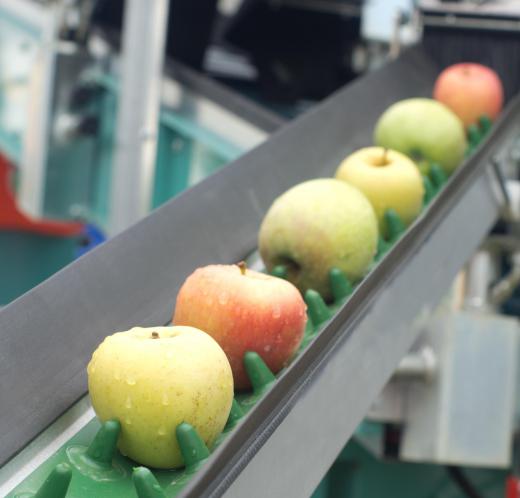At AboutMechanics, we're committed to delivering accurate, trustworthy information. Our expert-authored content is rigorously fact-checked and sourced from credible authorities. Discover how we uphold the highest standards in providing you with reliable knowledge.
What Is a Food Conveyor Belt?
A food conveyor belt is a strip of some type of material that moves to carry food from one spot to another; it is typically seen in food processing plants. Industrial food conveyor belt systems are used to move pre-processed food to processing and sanitation stations, and to move post-processed food into packing stations. This belt is used to handle food, so most regions and countries have sanitation regulations in place to ensure the food does not rot during conveyance and consumers are safe. The belt itself is generally not as wide as other conveyor belts, because food items are generally much smaller than other items moved by a conveyor belt. While this conveyor belt is typically used in processing plants, a food conveyor belt also is often used in Japanese restaurants to rotate sushi plates to every table.
The most common place for a food conveyor belt is inside a food processing plant, where food items such as meat and vegetables undergo processing before they are sold to the public. Food items are first loaded onto a conveyor belt, which usually has small bays to help hold the items. Such as conveyor belt takes the food to sanitation stations for cleaning before carrying it on to processing stations to be cooked, flavored, cut, etc. After the processing is complete, the conveyor belt is used to carry the items to packing stations or workers, so the items can be packed and shipped to stores.

Sanitation is a major concern when a food conveyor belt is used, because a belt with contaminants or diseases can infect the food, causing consumers to become sick. For this reason, most food conveyors are steam-cleaned regularly to kill any harmful bacteria. The level of required cleanliness varies among countries and regions, but most have very stringent rules that must be followed if the processing plant is to avoid fines and remain open.

Most conveyor belts are wide, so a large number of items can be placed on the belt. Food conveyor belts are typically thinner, because food items are generally smaller than items processed in other processing plants. This also helps separate food items, which can be useful when processing the food into a product.
Generally, a food conveyor belt is only found inside a processing plant, but some models also are used in restaurants, particularly in Japan. In automated sushi restaurants, chefs place sushi platters on a food conveyor belt that moves the plates among tables in the restaurant so customers can take the sushi they want from the belt. These belts are generally much thinner than those found in manufacturing plants and are typically wide enough to hold a small plate.
AS FEATURED ON:
AS FEATURED ON:












Discuss this Article
Post your comments